Green Companies in Our Backyard…
…and the local initiative that’s putting them together to create a “green economy”
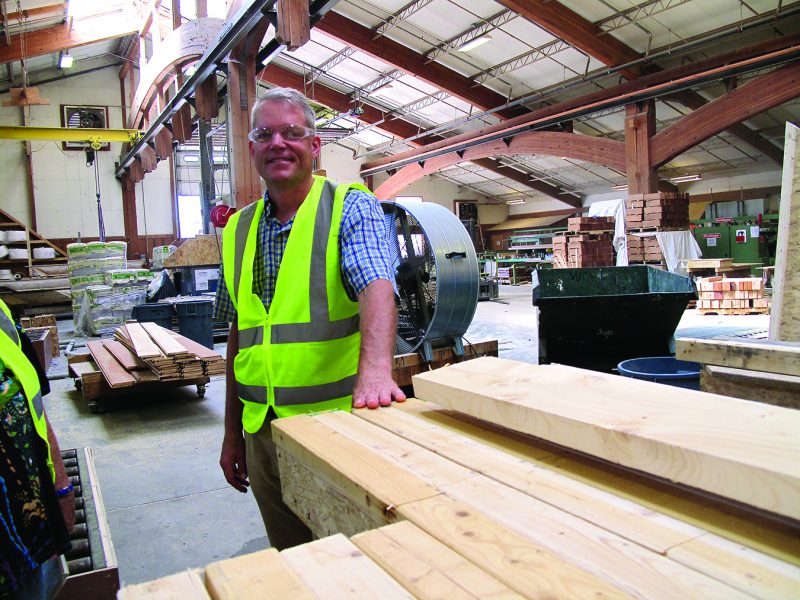
Andrew Dey of Unity Homes (photo Lynn Barrett)
By Lynn Barrett, Joyce Marcel, and Candace Pearson
Life has always seemed green in the Green Mountains of Vermont, with hiking and canoeing and farm-to-table dining around every corner.
But the ethic is more than a lifestyle; these deep-rooted values of sustainability have fostered innovation and expertise in a surprising number of companies that have quietly been attracting the attention of multinational companies, federal agencies, and high-power investors for years.
They may be hidden in the foothills, but these small companies are putting Southern Vermont and the Pioneer Valley region at the forefront of what is poised to become an economic boom of jobs in the green economy, according to experts.
High Growth on the Horizon
Nationally, the green construction sector alone contributed approximately 6.4 million jobs from 2011 to 2014, according to a report prepared by the U.S. Green Building Council, and is projected to nearly double in the next three to five years.
Green bonds increased from $11 billion in 2013 to $100 billion in 2015 — a 300-percent increase per year. Most of those bond issuances are drastically oversubscribed, and the demand is only predicted to grow as national demographics shift. Millennials currently account for 50 percent of all impact investment dollars, even though they represent just 10 percent of high net worth individuals.
Investors won’t find a more organized group of green companies than those in Stratton’s own backyard. National and federal grants have allowed private companies, colleges, and nonprofits from Windham County, as well as three other counties spanning across state lines (Bennington in Southern Vermont, Cheshire County in New Hampshire, and Franklin County in Massachusetts) to network together and to collaborate on new business opportunities.
The initiative, known as the Green Economy Innovation Hub (GEIH), has connected more than 120 businesses, colleges, and organizations thus far.
Here are just a few examples of the hidden-gem businesses in the GEIH that are on the leading edge of the green economy — as well as their leaders’ visions for what could come next. All are located within two hours of Southern Vermont ski slopes.
BENSONWOOD
LOCATION: WALPOLE, NEW HAMPSHIRE
NUMBER OF EMPLOYEES: 100+
TYPE OF BUSINESS: CUSTOM TIMBER FRAME BUILDER
Claim to fame: Tedd Benson, founder of Bensonwood, is widely recognized for reinventing the timber frame home for the 21st century. The company prefabricates the pieces of their high-end, energy efficient, healthy homes — and the occasional Japanese bathhouse — at headquarters. Then they shrink-wrap them and ship them to construction sites all over the country. Annually, Bensonwood creates between 50 and 60 custom homes — Benson calls them “legacy homes” — that can cost a million dollars or more.
In 2012, Benson started a separate company called Unity Homes, which seeks to bring down cost by using more prefabrication and less customization. Unity currently produces roughly 20 houses a year for between $200,000 and $325,000.
“We think the American consumer, in general, is pretty underserved by the home-building industry,” Benson said. “We can do better. Unity is scaling up to make this higher quality, very energy-efficient, very green home an affordable standard across the country.”
What’s next: Chief Operating Officer at Unity Homes, Andrew Dey has been spearheading research aimed at understanding the region’s wood resources and finding potential applications for new engineered wood building products. Cross-laminated timber (CLT) has risen to the top as a possible candidate.
CLT is a structural panel, which in most applications can replace steel or concrete. With this product, it becomes possible to build high-rise buildings — 6 or 10 stories tall — completely out of wood. In collaboration with other partners in the Green Economy Innovation Hub, Dey is exploring whether a CLT manufacturer could locate in the region and become the first supplier on the East Coast. Bensonwood and others could then specialize in building with this game-changing product.
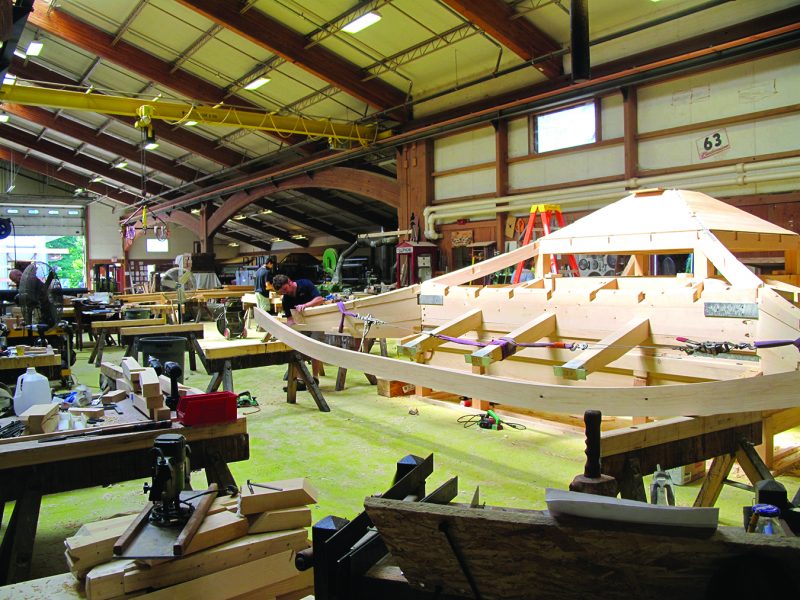 Bensonwood Workshop (photo Lynn Barrett)
Bensonwood Workshop (photo Lynn Barrett)
BUILDINGGREEN
DISCLOSURE: ONE OF THE CO-AUTHORS, CANDACE PEARSON, IS A BUILDINGGREEN EMPLOYEE.
LOCATION: BRATTLEBORO, VERMONT
NUMBER OF EMPLOYEES: 15
TYPE OF BUSINESS: INFORMATION PUBLISHING AND CONSULTING
Claim to fame: BuildingGreen produced the first North American publication devoted to the then-nascent field of green building, and it continues its trusted thought leadership today. Approximately 10,000 readers subscribe to its website, allowing the company to focus on independent reporting. Throughout its history, BuildingGreen experts have been sought for their consulting services and have produced reports for the U.S. Green Building Council, American Institute of Architects, U.S. Department of Energy, and the U.S. Department of Housing and Urban Development. Their team is now in demand across the country to provide custom services for professional associations, large portfolio owners, and architectural teams in the midst of a big project.
What’s next: With a finger always on the pulse of the industry, BuildingGreen points to buildings that have been certified to the Living Building Challenge (LBC) as some of the greenest buildings ever created. These include the Bullitt Center in Seattle, Washington and Brock Environmental Center in Virginia Beach, Virginia. The standard calls for net-zero energy, net-zero water, and a stringent material selection process.
The same organization that runs LBC recently launched a spinoff standard for entire communities: The Living Community Challenge. A handful of communities have registered, but none have yet reached certification. It will be a race to the finish line, as the first community to be certified will be nationally recognized, attracting visitors and researchers alike.
BuildingGreen would like to see that designation go to a community in the Green Mountains. The company has the technical expertise to help make it happen and could partner with local builders and suppliers.
“When I visited Sweden, I saw a city that had committed to being fossil-fuel free, and they now have visitors from all over the world paying to tour their city. I think we could have something similar here,” says Alex Wilson, founder of BuildingGreen.
GREEN RIVER
LOCATION: BRATTLEBORO, VERMONT
NUMBER OF EMPLOYEES: 18
TYPE OF BUSINESS: SOFTWARE AND WEB DEVELOPMENT FOR SUSTAINABILITY, ENVIRONMENTAL PROTECTION, SCHOOL IMPROVEMENT, AND PUBLIC HEALTH.
Claim to fame: Reaching sales of close to $3 million per year, Green River is responsible for the platform that Starbucks uses to manage its enormous supply chain. Since 2006, Green River has been helping Starbucks to implement its ethical trade certification program, called Coffee and Farmer Equity (C.A.F.E.). The company had set a goal to have all suppliers certified, but was tracking progress using cumbersome spreadsheets. Green River’s solution allowed the company to drastically scale up certification efforts, and in 2015, 99 percent of coffee purchased by Starbucks was certified in C.A.F.E. practices.
Another major project that has placed Green River on the international stage has been its work for GRESB, a platform for disclosing the sustainability performance of real estate portfolios for major institutional investors around the globe. GRESB currently reports on the environmental, social, and governance characteristics of more than $2 trillion dollars in real estate property. This kind of data is helping investors all over the globe to understand how green building investments pay off; a recent study by the University of Cambridge using GRESB data showed that real estate investment trusts with higher sustainability ratings had a better return on assets and return on equity, when adjusted for risk.
What’s next: A typical property listing on the web shows a home’s price, school district, and “walk score.” This number, created by the website WalkScore.com, calculates how walkable and transit-friendly a given location is based on a variety of data streams. Michael Knapp, the president of Green River, envisions creating similar software for calculating a property’s level of resilience to natural disasters (relying in part on the expertise of BuildingGreen and its sister organization, the Resilient Design Institute). This could help insurance companies and property owners better understand levels of risk and help promote urban planning and building techniques to mitigate those risks. Those techniques often overlap with green building techniques, such as adding insulation so that livable temperatures are maintained even when the power goes out.
“We move here because it’s spectacularly beautiful,” says Michael Knapp, president of Green River. “We have no billboards on our highways. And it’s how we treat the environment
that models our work.”
CENTER FOR CLIMATE PREPAREDNESS AND COMMUNITY RESILIENCE
LOCATION: KEENE, NEW HAMPSHIRE
NUMBER OF EMPLOYEES: 10
TYPE OF BUSINESS: EDUCATION AND APPLIED RESEARCH
Claim to fame: This small research center housed at Antioch University New England has won the favor of the U.S. Environmental Protection Agency. In 2014, it was asked to convene planners to test out version 1.0 of the Obama Administration’s Climate Resilience Toolkit. Since then, its status as “convener” has expanded to include organizing the Northeast Climate Change Preparedness Conference, which attracts more than 500 participants from all over the nation.
What’s next: Antioch recognizes itself as just one link in what could become a full-service green economy Educational Consortium.
Other partners identified through the GEIH tackle different parts of the education chain: Keene State has a state-of-the-art product prototyping and design center; World Learning’s School for International Training sends students all over the world to focus on sustainable development; Greenfield Community College offers a popular renewable energy and energy efficiency certificate and degree; and the Sustainable Energy Outreach Network holds popular trainings for incumbent practitioners.
Connecting curriculum and resources would create the first comprehensive education chain serving the green economy — from high school to PhD programs, spanning more than 200 career pathways. That kind of approach would open the field for attracting even more federal and private research dollars.
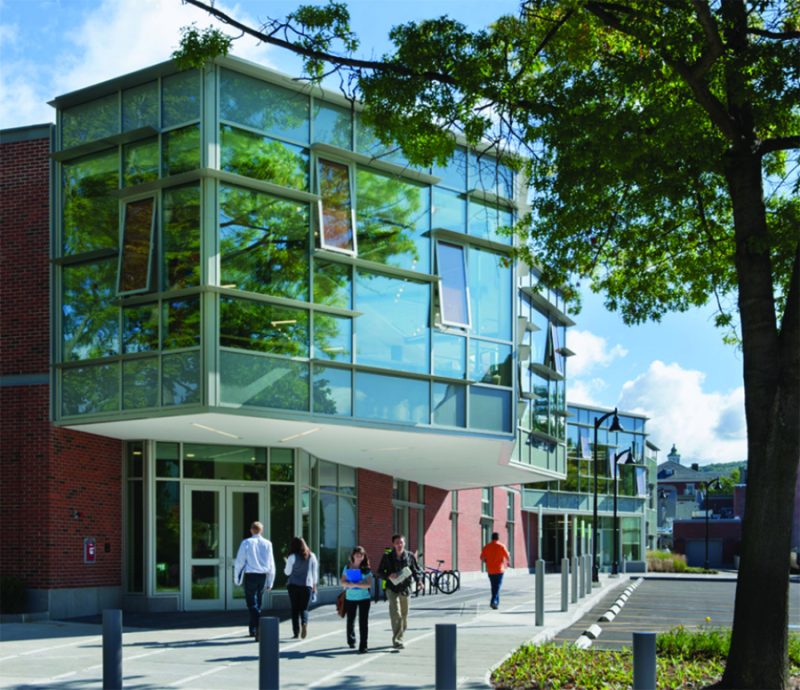 Technology, Design and Safety Center at Keene State
Technology, Design and Safety Center at Keene State
RICH EARTH INSTITUTE
LOCATION: BRATTLEBORO, VERMONT
NUMBER OF EMPLOYEES: 4
TYPE OF BUSINESS: NUTRIENT RECYCLING RESEARCH AND DEMONSTRATION
Claim to fame: In a time when droughts are crippling some of the world’s biggest cities and synthetic fertilizers pollute a large portion of the water that is available, the solution just might lie in a few scattered hayfields in Vermont.
Brattleboro’s Rich Earth Institute is the only nutrient-recapturing project in the country, and it just received an $830,000 federal research grant to take its scientific research farther. This nonprofit collects human urine, pasteurizes it, and spreads it as fertilizer on hayfields. The idea is to both restore the natural nutrient cycle and also to save our clean water for other uses, besides flushing toilets.
What’s next: Kim Nace, one of the co-founders of Rich Earth Institute, believes that there are several opportunities to turn the company’s research into thriving businesses. Nace is already working with a local port-a-potty company called Best Septic Services to develop a composting toilet version that uses hay instead of blue chemical goop. This technology has the potential to reduce operating costs for Best Septic as it reduces the amount of waste that has to be treated. If you consider every port-a-potty on every construction site or concert venue — that ends up being a lot of waste.
“We’re probably as surprised as everybody about how well this has taken off,” Nace said. “We’ve been passionate about it and stuck hard to the science.”
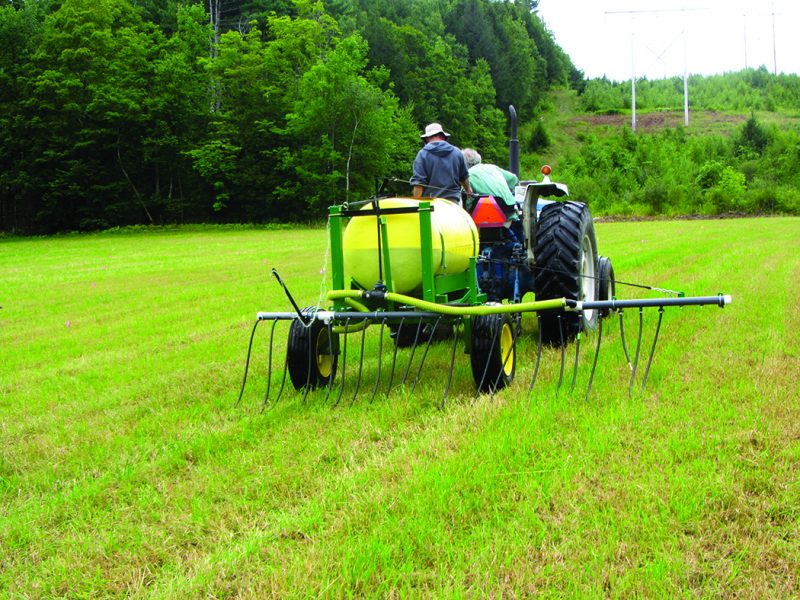 Fertilizer generated from human urine spread on farmland (photo Rich Earth Institute)
Fertilizer generated from human urine spread on farmland (photo Rich Earth Institute)
The Power of the “Hub”
You might have noticed a trend in these leading businesses’ new project pitches: they are partnering with other local businesses in the GEIH to access national markets. It is a simple idea, but one that took years to take shape.
The impetus came from a series of disasters that left the region reeling. Among them was the devastation caused by Tropical Storm Irene. More recently, it was the closing this year of the Vermont Yankee nuclear power plant in Vernon, Vermont. The closing brought with it the loss of 600 high-paying jobs, plus services, volunteers, and charitable giving.
In response, the Brattleboro Development Credit Corporation (BDCC) and Southeast Vermont Economic Development Strategy (SeVEDS) led an investigation to look for economic development opportunities. The resulting Comprehensive Economic Development Strategy report was the first to document the region’s unique number of companies related to the green economy.
“The vast majority of successful innovation occurs because there’s a network of creative and innovative people and organizations in one area who are bumping into each other and exchanging information and ideas,” says Frank Knott, of ViTAL Economy. Knott was brought into the region by BDCC to help create the GEIH.
“Until the GEIH was pulled together, most of the people thinking green didn’t know the others existed,” continues Knott. “Now they are starting to partner with each other.”
But the effort is more than about sparking a few new business ideas. Uniting regionally is laying the foundation for a geographic-based reputation that can be recognized nationally; what Silicon Valley is to technology, this four-county area seeks to be for the green economy.
“Networking together with the GEIH is a brilliant strategy in response to the closing of Vermont Yankee,” says Knapp of Green River. “We’re really here to create a new economy that’s focused on sustainability and resilience. And the world needs it. That our local community is recognizing it is music to my ears.”
MORE INFO
Brattleboro Development Credit Corporation (BDCC)
www.brattleborodevelopment.com
Laura Sibilia, Director of Economic and
Workforce Development — SeVEDS
802-257-7731
Resilient Design Institute
www.resilientdesign.org
Alex Wilson, President, Board of Directors
802-257-7300
Vital Economy Alliance
www.vitaleconomy.com
Frank Knott, President
410-321-1484
PETE CONRAD CONSTRUCTION BRINGS QUALITY AND ENERGY EFFICIENCY TO THE STARTER HOME
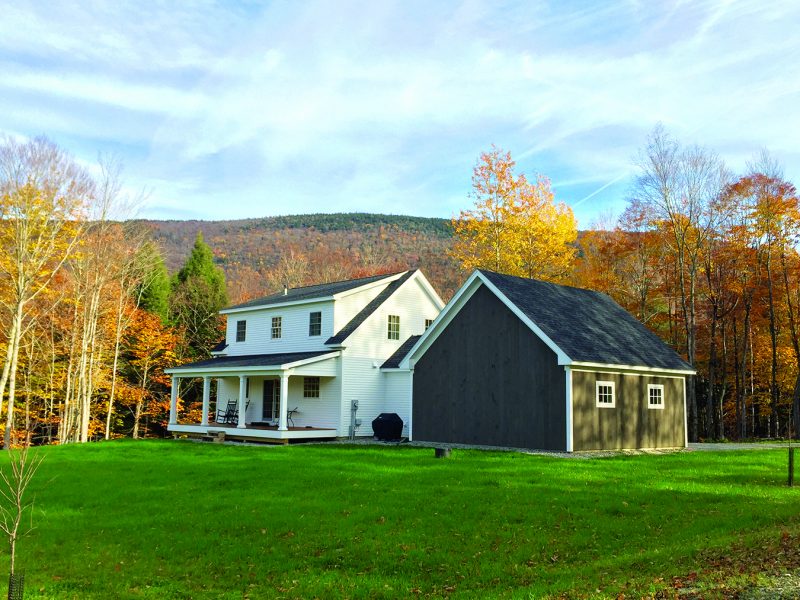
Pete Conrad is no stranger to luxury home building; he has made a name for himself on large-scale remodels and multimillion dollar homes.
But these days he is turning his sights to a different audience: working-class families in need of a starter home.
“We are starting to see a lot of new families moving to the area, coming here to work at local businesses,” Conrad told Stratton Magazine. “They are working families, and their biggest asset will be their home.”
Conrad wants to make sure that home is energy efficient and made of high-quality materials so that it will carry the best resale value. He’s created a dedicated line of homes to
deliver on that promise, starting at the reasonable price of $325,000.
These homes are a part of his “Hybrid Home Program” — hybrid because the architectural details are standardized, allowing the company to deliver the product more quickly and efficiently (and thus less expensively), but also customizable and stick-built, as opposed to prefabricated.
Conrad also sources his materials from local material suppliers — sometimes, from the very land that is cleared to build the new house. If a homeowner agrees, Conrad will use pine that is cut down from the lot for a home’s floor or ceiling.
“We are doing three homes a year now,” Conrad says. “And practically one new family a month wants to talk with us. These are the people who want to come here to do better
for themselves, and they’re always a pleasure to work with.”
THINKING “TINY” AT GREEN MOUNTAIN COLLEGE
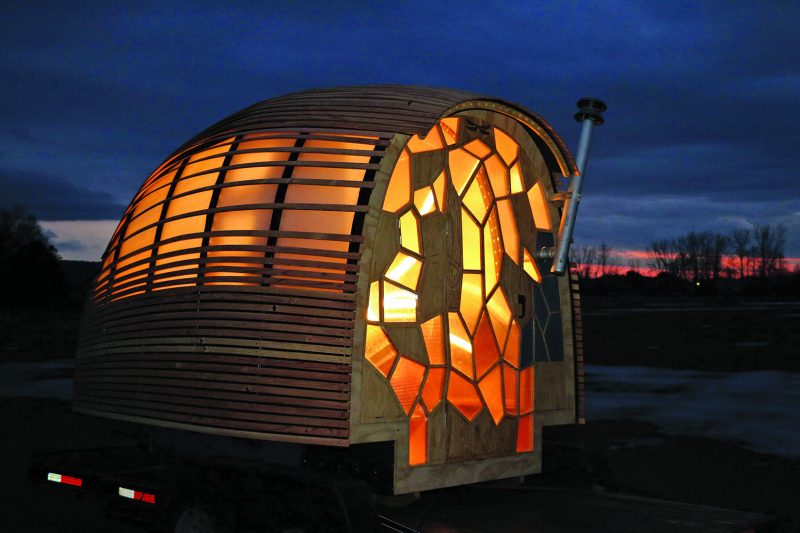 Green Mountain College
Green Mountain College
As one of the first institutions that specialized in ecological thinking, Green Mountain College continues to push the boundaries of current-day environmental liberal arts education. Students at the college recently made national headlines for constructing a pod-shape tiny house that they designed in class.
The home, called OTIS (Optimal Traveling Independent Space) contains a bed, desk, composting indoor toilet, sink, and stove. Water needs are met through a rainwater harvesting system and electricity is supplied by solar panels attached to the dwelling.
The class will be repeated this year and an OTIS 2 will be constructed, Green Mountain College President Robert Allen told Stratton Magazine. That is just one example of how sustainability coursework is attracting the brightest minds and demonstrating relevance beyond higher education’s ivory towers, says Allen.
“Students come to us because they know we are the real thing. Vermont as a state has a reputation for taking a stand on things and championing causes that are going to be important to the world — that cause now is sustainability.”

